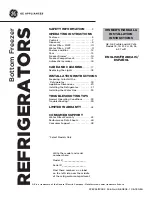
Component Testing
©2007 Viking Preferred Service
23
Component Description
Test
Procedures
Condenser
Condenser is a tube and wire
construction located in machine
compartment.
Condenser is on high pressure
discharge side of compressor.
Condenser function is to transfer heat
absorbed by refrigerant to ambient.
Higher pressure gas is routed to
condenser where gas condenses into a
high pressure liquid state. Heat transfer
takes place because discharged gas is
at a higher temperature than air that is
passing over condenser. Adequate air
flow over condenser must be
maintained.
Condenser is air cooled by condenser
fan motor. If efficiency of heat transfer
from condenser to surrounding air is
impaired, condensing temperature
becomes higher. High liquid
temperature means liquid will not
remove as much heat during boiling in
evaporator as under normal conditions.
This would be indicated by higher than
normal head pressures, long run time,
and high wattage. Remove any
obstruction that would restrict normal
air movement through condenser.
From condenser the refrigerant flows
into a post condenser loop which helps
control exterior condensation on flange,
center mullion, and around freezer
door. Refrigerant then flows through
the drier to evaporator and into
compressor through suction line
Leaks in condenser can usually be detected by using
an electronic leak detector or soap solution. Look for
signs of compressor oil when checking for leaks. A
certain amount of compressor oil is circulated with
refrigerant.
Leaks in post condenser loop are rare because loop
is a one-piece copper tube.
For minute leaks
1. Separate condenser from rest of refrigeration
system and pressurize condenser up to a
maximum of 235 PSI with a refrigerant and dry
nitrogen combination.
2. Recheck for leaks.
WARNING
To avoid severe personal injury or death from
sudden eruption of high pressures gases,
observe the following:
Protect against a sudden eruption if high
pressures are required for leak checking. Do not
use high pressure compressed gases in
refrigeration systems without a reliable pressure
regulator and pressure relief valve in the lines.
Overload/Relay When voltage is connected and relay is
cool, current passes through relay to
start winding.
After a short time, current heats the
resistor in relay and resistance will rise
blocking current flow through relay.
Start winding remains in the circuit
through run capacitor.
Solid state relay plugs directly on
compressor start and run terminals.
Relay terminals 2 and 3 are connected
within relay. Run capacitor is
connected to relay terminal 3. L2 side
of 120 VAC power is connected to
relay terminal 2.
1. Disconnect power to the refrigerator.
2. Remove relay cover and disconnect leads.
3. Check resistance across terminals 2 and 3 with
an ohmmeter:
•
Normal = 3 to 12 ohms
•
Shorted = 0 ohms
•
Open = infinite ohms
Control board
See Control Board section for
troubleshooting information.
Ice Maker
See Ice Maker section for service
information.
Содержание DDBF036LSS
Страница 18: ......
Страница 50: ...Appendix A 50 2007 Viking Preferred Service NOTES ...
















































